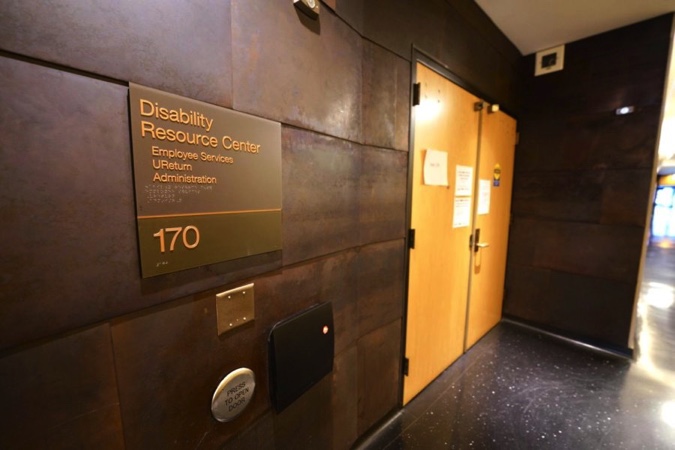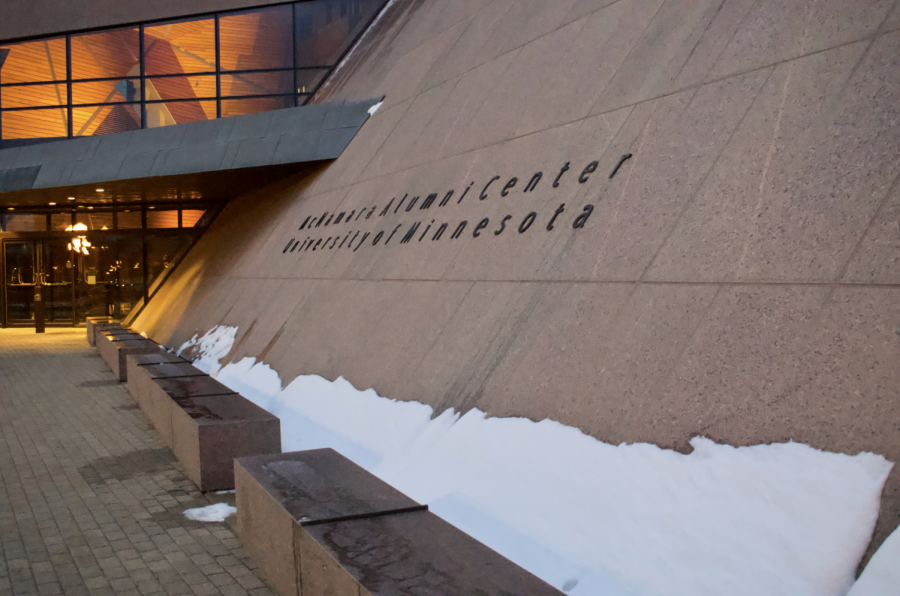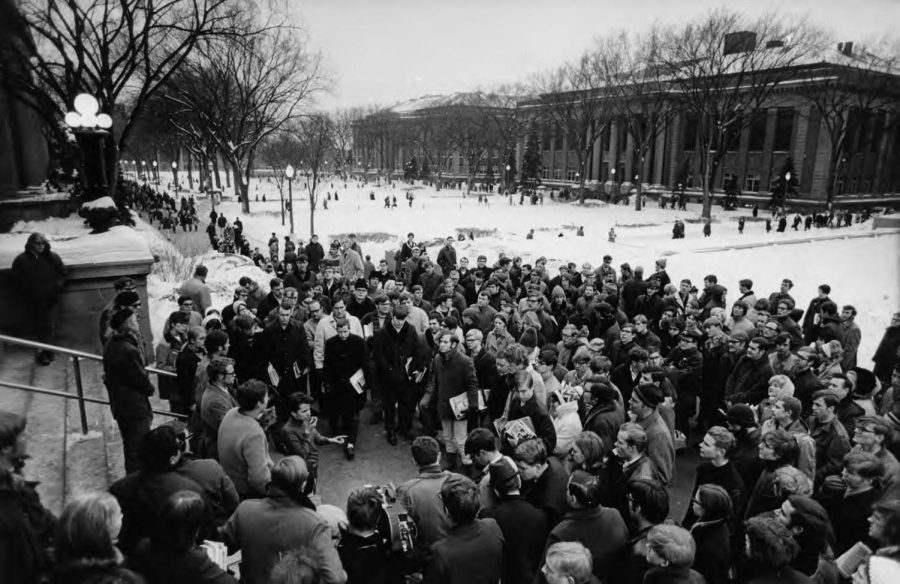Machines roar as student-workers sift through paper on a conveyor belt, pulling out misfit items like Pop-Tarts boxes and broken cellphone chargers.
Across the warehouse, classic rock blares from a secondhand stereo.
From boxes of professors’ discarded VHS tapes to a stainless steel hot tub tossed by the Athletics Department, the University of Minnesota’s unwanted junk fills the school’s Como Recycling Facility.
“You just never really know what’s coming out here,” said Nick Kluge, operations supervisor.
At the facility, workers have one main goal: preventing as much material as possible from going to waste.
Since the University launched its recycling program in 1984, its recycling rate has grown from zero to 42 percent. In its first decade, college recycling directors from around the country looked to the University as an example of waste management success.
But as the University’s campus has expanded — and as recycling needs have ballooned as a result — funding for the center has remained stagnant, leaving a limited staff and aging machinery to handle an average of more than 8,600 tons of waste each year since 2006.
Now, after years of battling rounds of doubtful administrators who’ve considered cutting or relocating the program, the center may receive approval for its first upgrade in two decades by the end of the year.
“We were a top-notch program then. We’re an okay program now,” said recycling supervisor Dana Donatucci, who started in his role in 1988. “We’re good. But what I’m trying to say is, we’re not getting the support that we really need to make this program go gangbusters. We can do a lot more.”
The business of trash
Drivers hit the roads at 5 a.m. to collect recycling and trash across the University’s campus. Sorters arrive at the center two hours later.
“We take equipment, and we make it work in this facility. It’s been described as trying to make a silk purse from a sow’s ear,” Donatucci said.
Drivers drop trash off at the Hennepin County Energy Recovery Center, where it’s burned for energy. Then, material from the school’s 15,000 recycling bins makes its way to the University’s facility, where it is manually sorted.
Bales of recycled goods are sold to about 20 regular buyers — such as paper mills — that continue the recycling process.
The University’s Facilities Management budgets around $2 million for the center annually, about $480,000 of which the facility and the ReUse Program earn through sales.
But the recycling program pays the Hennepin County Energy Recovery Center $75 to dispose of each ton of material — a cost totaling around $386,000 each year.

If the center can find a way to reduce the amount of trash it sends to HERC, it could use some of the funds to replace machines or subsidize other operational costs, said John Sundsmo, waste recovery services manager.
“We’re operating today with the same number of full-time employees that we’ve had for the last 20 years, even though the University has expanded greatly,” Sundsmo said. “The reason we’ve been able to do that is because we’ve been doing these little efficiency gains.”
In an effort to save money, the program started collecting organics in 2007 from dining halls, saving the center about $60 per ton in disposal fees.
Donatucci and his crew are now working on adding organics bins campus-wide.
Managers also constantly search for ways to improve their own workflow. They’ve added compactors outside buildings to reduce the number of times drivers need to pick up the material, for example.
And because value goes up based on how precisely materials are sorted, managers hope to add a full-time staffer who can ensure that all scrap metals in the construction debris yard get divided up as cleanly as possible to maximize revenue.
‘A support role’
Managers and staff have mastered working around inefficient machinery, missing tools and a volatile price market in order to meet the facility’s daily demands.
Depreciation on cardboard or glass values can mean thousands of dollars lost in sales. The center will hang on to materials for months, waiting for prices to rise, Kluge said.
“We stored plastic bottles for two years here when they weren’t worth anything,” he said. “We were almost at the crunch point where we didn’t know what to do with it because of our limited space.”
Federal regulation changes and corporate decisions can also cause setbacks.
Since the center can’t afford a shredder, University departments have stopped sending the facility legally protected documents, opting to pay an outside contractor to handle safe destruction. As a result, the recycling center has lost about $90,000 in potential revenue, Donatucci said.
In 2007, Donatucci presented a proposal that would enable the facility to collect and shred the documents, which was later rejected.

Interim Associate Vice President of Facilities Management Bill Paulus, who was part of the discussion at the time as director of Central Services, said administrators decided against the plan for financial and security reasons. Additionally, the shredder would create dust, which was a health concern, he said.
“I’m not convinced that there is a huge savings by the time you get everything considered,” Paulus said, adding that administrators didn’t conduct an exact comparison of costs.
After Coca-Cola Company signed a contract with the University in 1996, the influx of plastic pop bottles forced the recycling facility’s workers to use the same baling machine for both plastic and paper, slowing down the process.
And when the University negotiated a renewed contract in 2006, Donatucci took a tip from his peers at other colleges, and requested that Coca-Cola fund new equipment to account for the loss in revenue.
But the request grew complicated, Donatucci said, stalling the negotiation between Coca-Cola and University administrators.
“I got told to drop it,” Donatucci said.
Today, workers manually separate the plastic bottles from the rest of the aluminum and tin cans. They tie up bales of compacted recyclables with wire, and clear out the machine with a leaf blower to prevent cross contamination of paper and bottles.
With an additional, auto-tie baler, workers could speed up the 42-minute cleaning and tying process and triple the number of bales produced each day, Kluge, the operations supervisor, said.
Kluge oversees about 11 full-time drivers and sorters and eight part-time student-staffers that run the center’s operations.
Stacks of 1970s newspapers pulled from the paper stream and a 1987 Macintosh SE sit on the edge of Kluge’s desk. Trinkets like toy recycling trucks and a miniature, pink rollout trash bin decorate his office.
He hangs a 4-by-4-foot piece of gray felt with a sketch of the facility’s perimeter near his desk.
Tacked onto the board, old and new cardboard pieces indicate existing and wish-list machinery. He shifts them around, searching for a more efficient layout.
More than half of the machines are years overdue for replacement, Kluge said.
“Each day’s a great day when all continues working,” he said. “But every year that goes by, there’s more added to that list that already should have been replaced.”
Trying times are nothing new for the recycling center’s staff.
Though the center has come a long way since 1984, its needs still lag behind other University priorities.
“It’s just the nature of the University. We’re about teaching, research and outreach to the community,” said Paulus, who handles funding requests for the center.
“[Facilities Management] is a support role,” he said. “We need to be safe, cost effective; we need to be reliable and functional. That’s our zone. That’s where we want to be.”
Two reviews later, recycling program here to stay
 For schools as large as the University of Minnesota, in-house recycling centers are commonplace. Experts and industry veterans say the University is still in the top tier of college recycling despite its financial woes.
For schools as large as the University of Minnesota, in-house recycling centers are commonplace. Experts and industry veterans say the University is still in the top tier of college recycling despite its financial woes.
And across the country, many college centers face low budgets and skeptical administrators.
“We’re all struggling,” says Karyn Kaplan, who’s been with University of Oregon’s recycling center since the ’80s. “There’s some administrators that are proactive and understand that you need to deal with things in a waste management perspective, and then there’s other managers who think it’s just an unnecessary add-on.”
University of Minnesota administrators have questioned whether to keep the recycling center several times since its inception, Donatucci said.
The facility’s last review came after neighboring company Viking Materials asked to buy the space about three years ago.
Paulus, who was then directing the recycling program’s umbrella department — Central Services — hired consulting firm Louis Berger to evaluate the pros and cons of keeping the center.
“We knew that getting someone who does this as their business would make sense … and to be honest, they’re less emotionally attached,” Paulus said.
The report came out in the center’s favor.
The consultant compared the center’s services, operational costs and sustainability efforts with private companies’.
The University’s operation provides some services that private haulers just can’t, Paulus said of the consultants’ findings. For instance, the school’s center already knows how to handle recycling for large events and is flexible about its 5 a.m. pick-up to avoid campus congestion. A hauler would also place its own dumpsters around campus — an unattractive option.
The operational costs for a private company and the recycling center would be about the same, Paulus said. And the University’s sustainability efforts, like meticulously sorting materials, surpassed those of private companies.

While campus centers recover materials like Styrofoam, rare plastics and glass, most companies would let these materials fall into the waste stream. Companies will only collect a large quantity of any one good if they can make a profit.
Still, better sorting isn’t always profitable if a center can’t find a buyer, said Kent Kiser, publisher for Scrap Magazine.
So far, the University has had luck finding buyers for some of its super-sorted items.
“We [found] service is higher, operational costs are equal and environmental and sustainability components are better, so we said we should just keep doing this,” Paulus said.
Once administrators decided to keep the program, the University hired consulting firm Burns and McDonnell to evaluate whether selling the recycling building and moving the center would be profitable.
Ultimately, they decided the cheapest option would be for it to stay at its current Como location.
Now that the center can count on staying put, the school’s U-Construction began an assessment in November to judge the facility’s layout. Once the program gets word from U-Construction on what changes are feasible, it will present a proposal for improvements to Facilities Management. This time, managers are optimistic.
The center may get its auto-tie baler after all, Paulus said.
“The whole thing we’ve been trying to do for years is trying to change the habits of the entire University community,” Donatucci said. “So things take time, and I keep telling myself, keep working at it, it’ll eventually happen. And I think it’s finally happening.”















